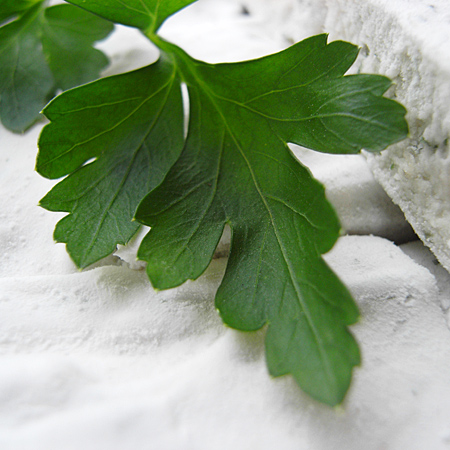
A while back I saw Evelin’s post on how to make marshmallows for Valentine’s day, and I knew immediately that I would like to give it a try. With TGRWT #2 coming up (that’s the second round of the food blogging event “they go really well together”), I thought I’d make marshmallows with a banana parsley twist. I figured that the banana flavour should fit very well with the soft and airy, yet elastic texture of marshmallows. And I was very curious to find out how the parsley would fit in!
Marshmallows were originally made using egg whites and the sap of the root of the marshmallow plant which were cooked with sugar and whipped into a foam. Today the marshmallow sap and egg white have been replaced by gelatin which is a protein produced from collagen in the connective tissue of animals. Proteins are good at stabilising foams (see previous post on how to make a Vauqelin). Addition of sugar increases the viscosity which stabilizes the foam even more. In marshmallows this is taken to an extreme. A large amount of gelatin is added to a concentrated solution of sugar (and corn syrup). This mixture is whipped for about 10 minutes to incorporate air and to break up larger air bubbles into smaller ones.
The first challenge was to find a suitable recipe. There are recipes that call for sugar only whereas others call for sugar and corn syrup (this recipe also gives a hint on how to substitute fruit purree for water). Corn syrup is added to prevent crystallization. Also some recipes use egg whites which are said to give a lighter texture. I decided to go for a simple recipe and used only sugar. I would also need to substitute mashed bananas for some of the water. Addition of parsley shouldn’t need any special adjustments of the recipe. I ended up with a recipe which is more or less a mixture of all these.
If you’re unsure about the process of how to make marshmallows, Cooking for Engineers has a detailed step-by-step description with pictures. The pictures at the end of this post should also give you an idea of what the texture is like. If you’re still lost, check out this video (the first in a series of six) on how to make mango marshmallows.
Banana marshmallows with parsley
65 g water
200 g sugar
10 g gelatin, bloomed in plenty of water
65 g banana, mashed
parsley (see comment below on why it shouldn’t be finely chopped)
Bring water and sugar to boil while stirring. Remove from heat when temperature reaches 110-115 °C (230-240 F). Add bloomed gelatin sheets and mashed bananas. Whip for 10 minutes (much longer than you think!). Add parsley to taste. Grease a pan, sprinkle with powdered sugar and spread mixture in pan. When set, invert pan on a surface dusted with plenty of powdered sugar and starch. Cut up in desired pieces and coat every cut surface with powdered sugar and starch.
What about the taste? I tasted the mixture before it set and was surprised by how well the banana and parsley blended together. To be honest, it tasted really nice! The next day however, after I had cut the marshmallows into squares, they tasted quite different. The parsley aroma had changed significantly and was more reminiscent of hay, so I was quite disappointed. The banana flavour was still intact, but I felt it was somewhat weaker than in the fresh mixture. Nevertheless, some guests I served it to reached out for both a second and a third piece of my banana marshmallows with parsley, so they couldn’t have been that bad after all. Perhaps it had to do with the texture which was really, really nice!
It turns out that the hay like off flavour of parsley is well known and described in the litterature! See for instance “Hay-like off-flavour of dry parsley” or “Evaluation of the effect of drying on aroma of parsley by free choice profiling”. The molecule responsible for the hay-like off flavour is 3-methyl-2,4-nonanedione. And apparently vacuum-microwave drying of parsley gives less hay flavour.
It is suggested that the hay like off flavour is formed by oxidation of unsaturated fatty acids or polyenes. As a consequence, I would suggest not to chop the parsley (or at least leave large pieces intact) to limit the exposure to oxygen. After parsley has been added, the mixture should be mixed carefully to keep the leaves intact. I used finely chopped parsley when I made the marshmallows in order to increase the release of volatile compounds from the parsley, and I think this is the main reason why I got the hay like off flavour.

Whip until you get a thick, creamy texture.


Spread in a pan greased with butter/fat and sprinkled with powdered sugar.


Using fruit puree in marshmallows – I absolutely love that idea! It really does make me think of all kinds of flavour combinations – not only using fruit, but vegetables as well.
And thanks for the information on parsley, it’s really helpful!
To get rid of the hay like off flavor, you suggest not cutting the parsley too finely in order to reduce the oxidation… I would suggest using freeze-dried parsley instead. But make sure to by the “˜good’ variety, as the cheap stuff already smells like hay, when you open the jar for the first time. I prefer Gutess (http://www.kraeuter.de), which is just great, it even comes in an “˜organic’ variety!
Evelin: Yes – you can basically use whatever fruit purree you like instead of bananas. And marshmallows are really an exciting “aroma carrier” since they have no aroma of their own!
Mirko: I’ll have to investigate what kind of prossesed parsley is commercially available here in Norway. It’s interesting that you mention freeze drying – the abstract of one of the articles I mentioned above says that “air-drying at ambient temperature produced less changes in aroma characteristics than the other drying methods and preserved the fresh and herbaceous notes” (other drying methods refers to air drying, oven drying and freeze drying). The abstract of the other article says that “Air drying at ambient temperature resulted in few losses in volatile compounds compared with the fresh herb, whereas oven drying at 45 °C and freeze-drying caused a decrease in the concentrations of the majority of the volatile components, especially those with the greatest impact on parsley aroma”. From this it seems that freeze drying is detrimental to parsley aroma, but could it be that they do something more than just freeze drying to retain the parsley aroma? BTW I seem to recall that air dried parsley also has this hay like flavour. Wonder how the industry tackles this problem in general?
Marshmallows! Delicious… Great idea, I will have to try this out… yum
Your posts are positively addictive, and I must admit I usually ready them twice through so I can convince myself I’ve understood every bit. Very fascinating results, and may I add, the blueberry vauqelin is wonderfully vibrant.
Would using parsley extract be better in this case? Because then u won’t be using the plant itself which the hay flavour resides in the fibres. Don’t use the commercial ones, make it yourself by pounding some parsley and passing it through a fine sieve. It would also add some color to the marshmallows.
Nick: Maybe it would work, but if the hay like off flavour is due to oxidation I can’t see how an extract should help since the compounds that are oxidized probably also would be extracted. But it could be worth a try. Perhaps someone has experience with this?
do you know this one?
Yes, I’ve seen the book. Can’t remember what it said about parsley though…
I work as a pastry chef and make marshmallows on a fairly regular basis.
One suggestion I have would be to use the paddle attachment rather than the whisk in your mixer while you’re making these. The whisk actually achieves less volume due to the viscosity of the cooling marshmallows.
Also.. the flavour of the marshmallow becomes less pronounced a few hours after making (or the next day as you mentioned) because the gelatine has locked up the flavours.
My favourite recipe for plain marshmallows that have a little more flavour is:
170g Sugar
85g Glucose (Corn Syrup if you don’t have glucose)
85g Honey
Vanilla (optional)
9g Gelatin
60ml Water
Combine sugar, glucose and honey.. bring to 122C/251F and remove from heat. Bloom gelatin… combine with 60ml of hot water (or replace with hot fruit juice/puree)..stir til gelatin is melted… combine with sugar/honey/glucose..
Beat in your mixer with the paddle attachment for 5 – 10 minutes at high speed. Put on a piece of parchment that has been brushed with butter. Put another piece of parchment on top and roll to desired thickness. Liberally cover with icing sugar and cut marshmallow, first into strips.. stopping to put icing sugar on each exposed surface, and then into cubes
Sandoz,
It’s great to have some tips and hints from a professional! You make a very good point about the flavour beeing locked up in gelatine. Do you have any suggestion on how to avoid this? Could addition of oil as an aroma carrier help?
And thanks for sharing the recipe!
I wonder if a free radical scavenger like citric acid might help here. I do not know if it would have a negative effect on the rest of the marshmallow alchemy.
Yes, an oxygen promoted oxidation could perhaps be halted with lemon juice. If it’s enzymatic, I’ve considered blanching. I hope to do some comparisons soon!
If you do not already have it, you might want to get some anhydrous citric acid powder.. that way you can titrate the exact amount needed.
http://www.lorannoils.com/Productsdetail.asp?SearchName=CITRIC%20ACID%20(ANHYDROUS%20GRANULAR)
How excatly would you titrate the correct amount?
T: trial and error – lots of marshmallows aged and tested with different amounts of citric acid and at different timepoints.. also need to establish some sort of relatively subjective and arbitrary metric for endpoint (hey this isnt rocket science nor nobel level research here)
I have been making marshmallows on a regular basis and have used oils for flavoring…they produce a nice, flavorful marshmallow, but the taste lingers on the tongue for a while. Nice, if you like that sort of thing. I have also used lemon or lime juice as the liquid for the gelatin with wonderful, tasty results. I find there are different schools of thought in regards to heating the sugar/syrup solution…some say 240 F while others say 250 F…I find with the higher degree it is a much stickier substance to work with and a much “chewier” and denser end product. Thank you to the chef for the suggestion of using the paddle…I will give that a try.
[…] TGRWT #2 I made banana marshmallows with parsley. The texture came out nice, but the initially fresh parsley flavour had become grassy/hay-like over […]
marvelous and you may try mint instead of parsley